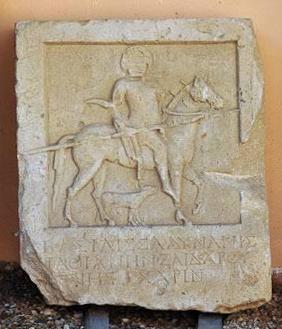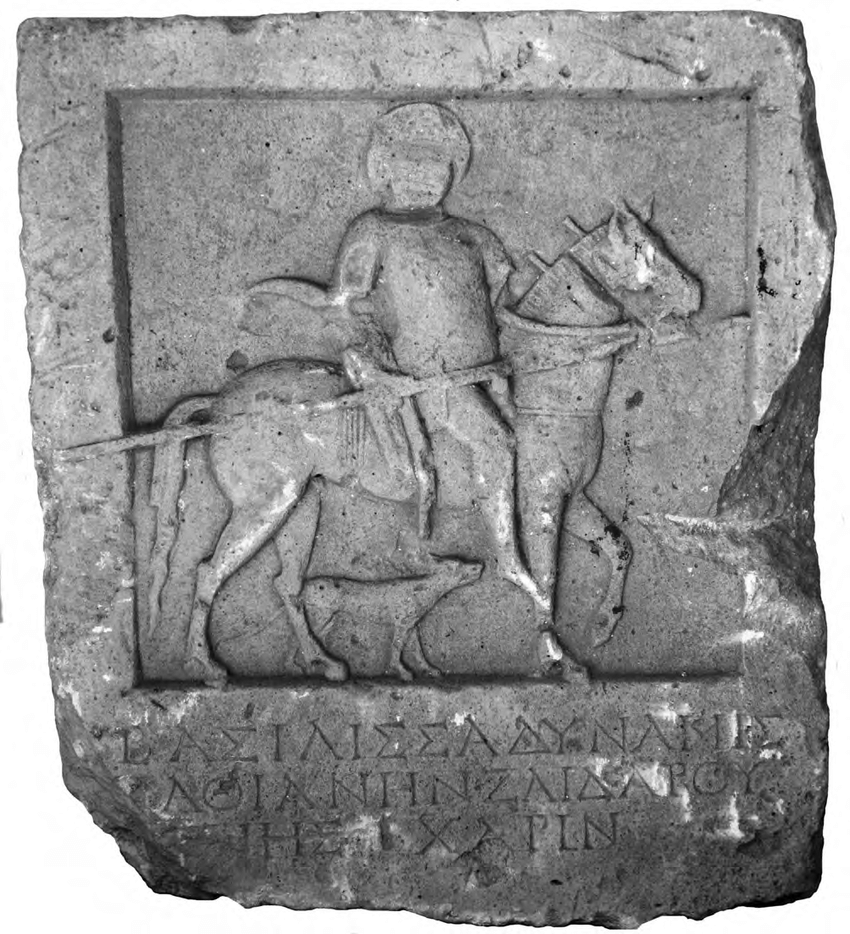Try Amazon Audible Premium Plus and Get Up to Two Free Audiobooks

Register a SNAP EBT card with Amazon
Grave Stele of Mathianes, the son of Zaidar, Bosporan Kingdom, c. 1st Century AD.
Temryuk Historical and Archaeological Museum, Russia.

Image source: Темрюкский историко-археологический музей (Temryuk Historical and Archaeological Museum)
BASILISSA DUNAMIS MAQIANHN ZAIDAROU [MNH]HMHS CAPIN
Referenced as Fig. 1. Grave monument to Matianes, the son of Zaidar (Temryuk museum) in "Aspurgians and the Military Policy of Bosporus at the Turn of the First Century AD" by V. A. Goroncharovskii, pp. 61-65 in Greeks and Natives in the Cimmerian Bosporus 7th – 1st Centuries BC (2000)
p.61:
From the end of the 1st century BC, the political situation in Bosporus was defined by the interaction of the kingdom with its three major neighbours:
(1) the later Scythians populating the areas to the west,
(2) the Sarmatians on the east and
(3) the Romans who were highly interested in having a buffer-state on the north-east of their Empire.
To a certain extent, the situation was influenced by the Aspurgians – the descendants of the nomadic Sarmatians1 –
who settled down in the Asian part of the Bosporan Kingdom between Phanagoria and Gorgippia.
1 In this case, one can obviously agree with M.I. Rostovtsev, who believed that the Aspurgians had been not a tribe,
but the militia of King Aspurgus brought by the latter either from the littoral of the Sea of Azov or from the hinterland of Sarmatia
(Rostovtsev 1916, 16; Rostovtzeff 1919, 88). For the relevant historiography, see Saprykin 1985b, 65.
...
pp.61-62:
Matianes, the son of Zaidares (or -os), was one of the Aspurgian chiefs, who played an important role in the above events.
His grave stele found in the Temryuk region (Fig. 1) had been erected by queen Dynamis ‘in memory’ (Yailenko 1995, 220–24).
The fact that the dedication was made on behalf of a ruler is unique in the history of Bosporus and suggests the outstanding merits of the deceased and the special attitude towards him of the royal house.
In the upper part of the stele one can see an elaborately carved relief depicting a warrior on horseback.
This piece of art is evidence of the craftsmanship of its maker, who managed to convey such details as the high leather boots of the horseman, the tail-strap of the horse and its mane cut into crenels.
These details are definite attributes of the eastern nomadic milieu that were not common for Bosporus.
Rostovtsev, M.I. 1916: ‘Bronzovyi byust bosporskoi tsaritsy i istoriya Bospora v epokhu Avgusta’. Drevnosti 25 (Moscow), 1–26.
(Rostovtsev, M.I. 1916: ‘Бронзовый бюст боспорской царицы и история Боспора в эпоху Августа’. Древности 25)
Rostovtzeff, M.I. 1919: ‘Queen Dynamis of Bosporus’. JHS 39, 88–109.
Saprykin, S.Y. 1985а: ‘Mitridatovskie traditsii v politike Bospora na rubezhe nashei ery’. In Isaenko, A. (ed.), Antichnost i varvarskii mir (Ordzhonikidze), 63–86.

p. 169: Another Mathianes is mentioned in an epitaph carved in a relief depicting a horseman and erected in the name of Queen Dynamis:
Basilissa Dunamis Maqianhn Zaidarou [mnh]hmhs capin
(the precise find-spot is unknown; the inscription is now kept in the Temryuk Museum; Figure 3) (Iailenko 1987, 19, No. 8; Iailenko 1995, 220-224)7.
The erection of an epitaph in the name of reigning ruler is a unique occurrence in the Bosporos,
which would indicate that a special degree of intimacy existed between Mathianes and Queen Dynamis and also that he enjoyed very high status.
V. A. Goroncharovskii (2000, 56 = 2006, 44f; 2003, 33-37) suggests that Mathianes had been one of the leaders of the Sarmatian tribe of the Aspurgians,
which supported Dynamis in the course of her struggle against Polemon.
This hypothesis cannot be ruled out, although there are insufficient data available to support it.
Source: "Queen Dynamis and Tanais" by Askold I. Ivantchik & Sergey R. Tokhtas’ev, in PONTIKA 2008
Other Illustrations of Scythian, Cimmerian, Sarmatian, Thracian & Bosphoran Costume and Soldiers from the Black Sea Region
See also Scythian, Saka and Sarmatian Illustrations of Costume and Soldiers (and Pazyryk Culture, Yuezhi, Parthians, White Huns, Hephthalites and Alchon Huns)
Ancient Illustrations of Costume and Soldiers



